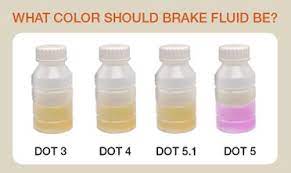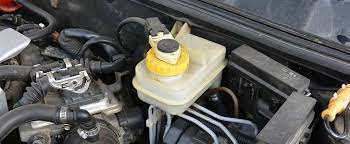A service issue with your vehicle may be indicated by discolored brake fluid. When you use the brake system properly, brake fluid won’t become faulty for a number of years. Before you can distinguish between what is typical and what is not, you must be aware of: what color is brake fluid supposed to be.
Flush it out if the fluid is older or contaminated and is a color other than honey brown. We’ll discuss the color of your brake fluid for you in this article. Please keep reading.
Why Use Brake Fluid?
Your Kia vehicle’s brake system requires brake fluid, a hydraulic fluid, in order to operate properly. Its ability to move the brake pedal is one of its more crucial tasks, but it also lubricates the entire brake system to prevent corrosion.
Your car’s safety and performance may be at risk if the brake fluid is not kept at the right level or if contaminants get into the fluid.
Why Is Brake Fluid Important?
The proper operation of your car’s brake system depends on the brake fluid. It both facilitates the effortless operation of the brake pedal and lubricates the entire brake system, assisting in the avoidance of troublesome problems like corrosion.
The performance of your car and the safety of you and other drivers may be at risk if your brake fluid runs out too soon or gets contaminated from the outside.
You must be careful to maintain the brake fluid, just like all of your car’s fluids. Your brakes could become prematurely worn out without it!
What Color Is Brake Fluid?
You need to buy a bottle of brake fluid when changing a master cylinder or brake pad. Brake oils come in three different types: DOT 3, DOT 4, DOT 5, and DOT 5.1. Different colors are present in these brake fluids.
The color of DOT 3, DOT 4, and DOT 5 brake fluids are the same. Over time, the color will become black or brown.
Regular heating, deteriorating rubber brake lines, moisture, and aging all cause the brake fluid’s color to change. In this brake fluid color guide, let’s discuss the various automotive brake fluids:
Dot 3
The DOT 3 brake fluid is a poly glycol-based product. It was one of the original brake fluids created, but as newer, more sophisticated brake fluids became available over time, it gradually lost favor. It has a minimum boiling point of 205 degrees Celsius. It has a wet boiling point of 140°C.
Depending on the operating conditions and climate, this brake fluid will absorb one to two percent water. Light trucks and domestic cars are best suited for regular driving with brake fluid.
The boiling point of this brake fluid is lowered as a result of moisture absorption from the surroundings. When DOT 3 brake fluid is brand-new, it is clear with a bluish tint. Except for DOT 5, it works well with all other brake fluids.
Dot 4
Using poly glycol as a base, this brake fluid is another. When dry, it has a minimum boiling point of 230 degrees Celsius, and when wet, a minimum boiling point of 155 degrees Celsius.
Modern higher and medium-sized vehicles use brake fluid. In addition, it is perfect for cars with ABS, high-speed braking, towing, and high altitudes.
The brake fluid absorbs moisture as well, lowering its ERPB (boiling point). Use caution when handling the fluid because it could damage the car’s paint. The DOT 4 brake fluid is nearly mineral clear in color with a trace amount of yellow. DOT 3 and DOT 5.1 are both compatible with it.
Dot 5

This brake fluid’s base is silicone. The temperature at which it boils wet is 180°C, and the temperature at which it boils dry is 260°C. The majority of the time, it is applied to military vehicles as well as old and weekend collector cars that are kept in storage. This brake fluid is incompatible with DOT 5.1, DOT 4, and DOT 3.
It neither absorbs water nor causes any harm to the paint on your car. Rubber formulations can also be used with brake fluid. The pedal feels bad because the fluid absorbs a lot of air. Due to its compressibility when exposed to high temperatures, it is therefore not recommended for racing cars.
Water in the DOT 5 brake fluid will result in severe localized corrosion, gassing, and freezing. This is because water is unsuitable for ABS because it is much heavier and does not mix with silicone fluids.
Due to foaming and aeration, this brake fluid is highly compressible during typical braking formation. It makes the brakes feel spongy.
Dot 5.1
Poly glycol is also the basis for DOT 5.1 brake fluid. Its minimum dry boiling point is 270°C, and its minimum wet boiling point is 190°C. In addition to delivery and fleet trucks, the fluid is perfect for racecars and towing vehicles.
DOT 4 and DOT 3 can mix with brake fluid without any issues. The boiling point of DOT 5 brake fluid is higher than that of DOT 4 and DOT 3 fluids. Additionally, this fluid draws moisture from the air, lowering its boiling point.
Paint may be harmed by brake fluid as well. Amber is the color of DOT 5.1 brake fluid.
Brake Fluid Change Procedure
It’s a little trickier to replace your brake fluid than to check it. A funnel, a set of socket wrenches, a brake bleeder kit, and other tools are required. Fresh DOT 3 or DOT 4 brake fluid is also required. Typically, the reservoir cap’s specifications can be checked to find the proper match.
The master cylinder can be discovered under the hood by first opening it. A “min” and “max” line will be present on the side, and it will be close to the firewall.
After removing the reservoir’s cap and sucking out the old fluid with a vacuum cleaner, add fresh fluid using a funnel. Cover the opening with a lint-free cloth to keep dirt out.
At each wheel, locate the small bleeder screw. To release the brake fluid, connect a hose from the brake bleeder kit and open the valve. Close the bleeder screw after maintaining flow until clean fluid exits into the hose.
Repetition at each of the four wheels should be done while topping off the reservoir frequently to keep the lines from becoming inflated.
After that, use the funnel to continue adding brake fluid until it reaches the “max” line.
You are now fully informed regarding brake fluid, including its color, function, and methods for checking and replacing it. Watch the brake fluid level and replace it when it appears black. Your brakes will be grateful.
How Do You Check Brake Fluid?
However, if you’re a DIY enthusiast, you’ll be happy to know that checking the brake fluid on your own is as simple as checking your oil level. The helpful technicians at the Hendrick Porsche service center in Charlotte will be happy to inspect your brake fluid for you.
Keep the following in mind as you inspect the brake fluid: How does brake fluid appear? You should schedule a service to have your brake system inspected if the texture, color, or overall condition seems off.
To check your brake fluid at home in Pineville, follow these easy steps:
- To access the reservoir of brake fluid under the hood, find the master cylinder. Your owner’s manual ought to include a diagram for reference if you need help locating it.
- The fluid reservoir will be marked with a minimum and maximum lines. If the brake fluid level is below the minimum line, you should top it off.
- What shade is brake fluid, in the end? You should have it flushed and replenished if it has turned a darker color or feels oily.



